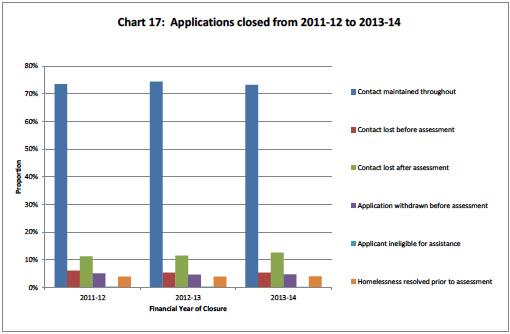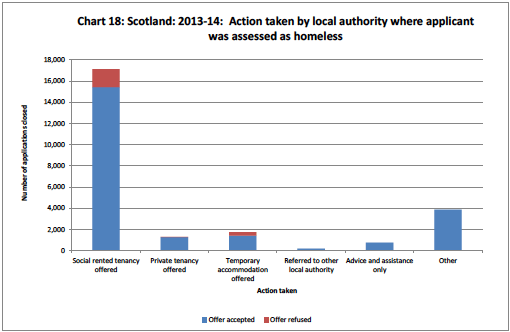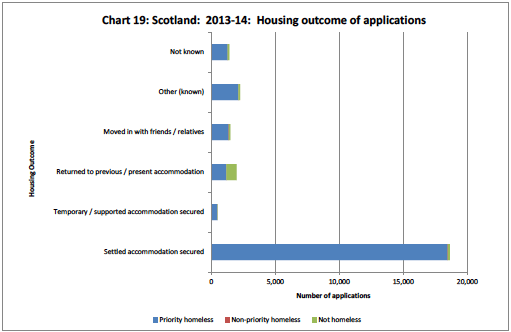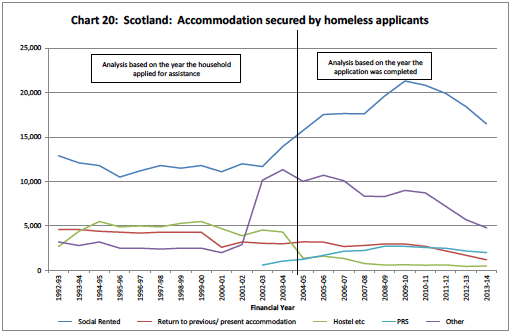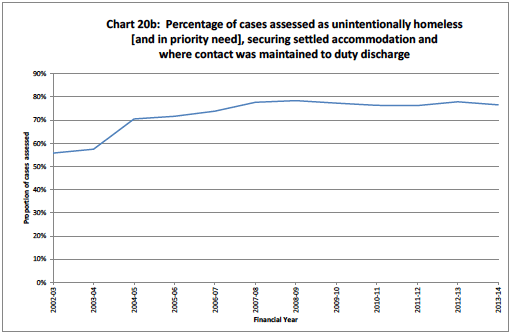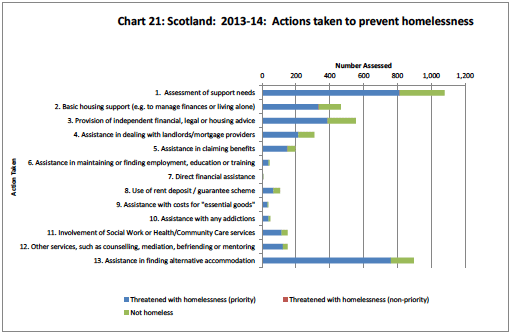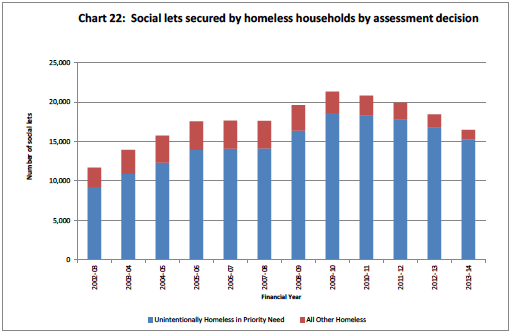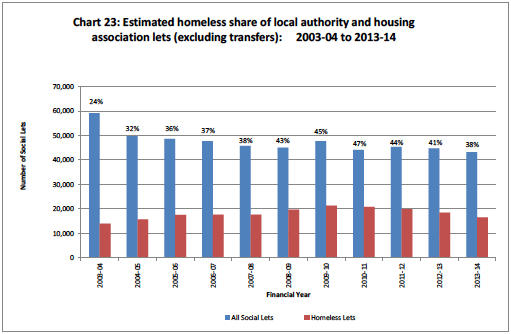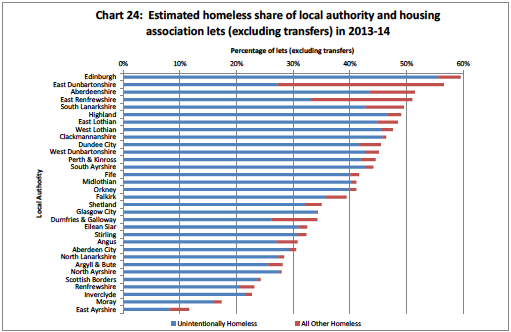Operation of the Homeless Persons Legislation in Scotland: 2013-14
This bulletin provides information on homelessness applications, assessments and outcomes to 31 March 2014. It includes information on the characteristics of applicant households, local authority assessments and the action taken in respect of cases that were concluded. Snapshot data on households in temporary accommodation at 31 March 2014 are also presented.
5. Outcomes (Table 8a to Table 11 and Chart 17 to Chart 21)
Contact maintained/ lost
5.1. In 2013-14, councils closed 36,010 cases. (Table 9a and Chart 17) Of these, contact was maintained until case closure for 26,352 applications (73% of cases). This was a decrease of one percentage point over 2012-13. In 2013-14 contact was lost before assessment for 1,915 (5% of cases) and was lost after an assessment in 4,522 (13% of cases). The overall proportion of lost contacts has increased by around two percentage points between 2012-13 and 2013-14.
Accommodation offered and taken up
5.2. Chart 18 and Table 8c show the offers of accommodation and outcomes for the 24,933 cases assessed as homeless, where contact was maintained until the application reached its conclusion in 2013-14. Of these, 17,123 were offered a social rented tenancy, most of whom (15,427 cases or 90%) took up the offer. Temporary accommodation was offered to 1,747 households, of whom 1,420 (81%) took up the offer; and a private rented tenancy was offered to 1,283 households, almost all of whom 1,262 (98%) accepted the offer.
5.3. The last actions of local authorities towards cases assessed as unintentionally homeless (and in priority need for cases assessed prior to 31st December 2012) remains very similar to 2012-13 with 69% of cases being offered a social rented tenancy and 5% being offered a private rented sector let. (Table 8d)
Overall outcomes
5.4. In 2013-14, settled accommodation was secured for 18,650 (71%) of the 26,350 applications where contact was maintained through to completion of the application. (Table 8b and Chart 19). Within this, 18,465 unintentionally homeless and threatened with homelessness cases (74% of such cases) secured settled accommodation.
5.5. Settled accommodation was also secured by 25 non-priority homeless. These cases were assessed prior to the abolition of the priority need test but duty was only discharged during 2013-14.
Note: This chart includes 44 non-priority cases that were assessed prior to the abolition of the priority need test, but which didn't have an outcome until 2013-14.
5.6. The number of homeless households securing a social let from either a local authority or housing association increased from 11,666 in 2002-03 to a peak of 21,316 lets in 2009-10. The total number of social lets to homeless households has fallen back slightly and now stands at 16,484 in 2013-14, mirroring the reduction in applications. Comparing 2013-14 and 2002-03, there has been an increase of 4,799 (+41%) social lets to homeless households. (Chart 20 and Table 8a)
5.7. There has been a marked increase in the number of homeless households securing a housing association tenancy - increasing from 1,488 in 2002-03 to a peak of 8,297 in 2009-10 since when it has reduced to 5,921 in 2013-14. The increase in housing association lets to homeless households is partly explained by stock transfers in six local authority areas [5] to housing associations created for this purpose. For these local authorities, what would have been classified as local authority lets are now classed as housing association lets.
5.8. Focusing on those with a right to settled accommodation - that is those assessed as unintentionally homeless and with whom contact was maintained through to duty discharge - the proportion securing settled accommodation has remained stable at around 77% since 2007/08 (Chart 20b).
Action taken to prevent homelessness
5.9. A question introduced from 1 April 2007 asks councils, at the time they close an application, to identify action they took to prevent homelessness for households assessed as threatened with homelessness or assessed as not homeless. Councils can record more than one prevention activity for each application. Chart 21 shows prevention actions taken for the 3,252 households who were assessed as threatened with homelessness or not homeless and whose case was closed in 2013-14. Of these, 1,079 (33%) were provided with an assessment of their support needs, 898 (28%) were provided with assistance in finding alternative accommodation, 555 (17%) received independent financial, legal or housing advice, 465 (14%) received basic housing support, 309 (10%) received assistance in dealing with their landlord or mortgage provider, 196 (6%) had assistance in claiming benefits, 106 (3%) were assisted to use a rent deposit/ guarantee scheme, for 151 (5%) a Social Work/ Health/ or Community Care service was involved and services such as counselling or mediation were provided for 151 (5%).
5.10. The distribution of prevention activities recorded for applicants remains broadly unchanged from 2012-13.
Note: Two applicants were assessed prior to the abolition of the priority need test as not in priority need, but the action taken to prevent homelessness was carried out after the abolition.
Homeless share of social lets
5.11. The majority of homeless households who secure a social let following their homeless application do so because they are assessed as unintentionally homeless and in priority need. In such cases an offer of a social let is made and the household accepts this. In addition to this, some other homeless households secure a social let during the period of their application - perhaps because they were already on a local authority or housing association waiting list. During the period of their homelessness application, they are offered and accepted a let. The homelessness statistics (HL1) system records both types of outcome. In other statistical sources (such as local authority and housing associations' letting statistics) the lets secured through the discharge of local authorities' statutory duties are often described as lets to statutory homeless or, in the case of housing associations, they are called section 5 referrals or homeless nominations.
5.12. Chart 22 shows the number of social lets secured by homeless households in each year since 2002-03, by homeless assessment decision. Over the period, numbers securing a social let by both means have initially increased and then fallen back as reductions in homelessness applications take hold. This reflects the initially increasing numbers of homeless households who have been given priority status, and then more recent reductions in homeless applications.
5.13. Overall homeless lets (statutory and other means) accounted for an estimated 38% of available social lets during 2013-14 (Chart 23). Since 2010-11, the proportion of social lets to homeless households has reduced by around three percentage points per annum.
5.14. Chart 24 shows for each local authority area the estimated [6] proportion of social lets (excluding transfer lets) secured by homeless households by assessment decision. The estimated proportion of social lets secured by homeless households in 2013-14 varied from 60% in Edinburgh to 12% East Ayrshire.
5.15. In East Dunbartonshire, 206 social lets were secured by cases assessed as homeless or threatened with homelessness. Of these, 99 were secured by cases assessed as unintentionally homeless. Of the remaining 107 social lets secured, the vast majority of these (104 out of 107) had been assessed as threatened with homelessness and unintentionally so. These households are likely to become homeless within two months. The Council is securing alternative accommodation before these households lose their existing accommodation. This approach has resulted in homeless and potentially homeless households securing over half of all available social lets - an estimated 57% of all non-transfer social lets in 2013-14. By maintaining a high enough proportion of lets to homeless households, East Dunbartonshire has continued the trend seen in 2011/12 and seen a small decrease in the number of homeless households in temporary accommodation.
5.16. Between 1 July 2013 and 31 March 2014 there were 20,568 cases assessed as unintentionally homeless or threatened with homelessness that were closed during the quarter. Of these, 5,721 were recorded as being assessed under the housing support regulations (28%), and 3,797 were recorded as having had support provided (66%) (see Table 11 and Summary of Current Legislation). Not all local authorities were able to report this information[7].
5.17. This is only the third quarter when information on the housing support regulations has been collected, hence a full financial year of information isn't available. Clearly, the monitoring of these regulations is still bedding in, but it is interesting to note that support was provided for around 1,200-1,300 cases in each quarter.
5.18. However, the number of cases assessed under the housing support regulations reduced by around 1,100 cases from the first quarter of collection (July to Sept 2013) to the second quarter (Oct to Dec 2013). This is despite the fact that the number of cases assessed as unintentionally homeless or threatened with homelessness was around the same (about 7,000 cases) in each quarter. Initially, there may have been some confusion across local authorities about when they needed to make an assessment under the regulations. However, as the guidance states, the duty to assess the need for housing support is relevant to every applicant assessed by the local authority as unintentionally homeless or threatened with homelessness and who the local authority has reason to believe would benefit from housing support services as prescribed in regulations. i.e. not all cases need to be assessed under the regulations. The number of cases assessed under the regulations has remained at around 1,500 cases for the last two quarters of 2013-14.
Contact
Email: Andrew Waugh or Ian Morton
There is a problem
Thanks for your feedback
